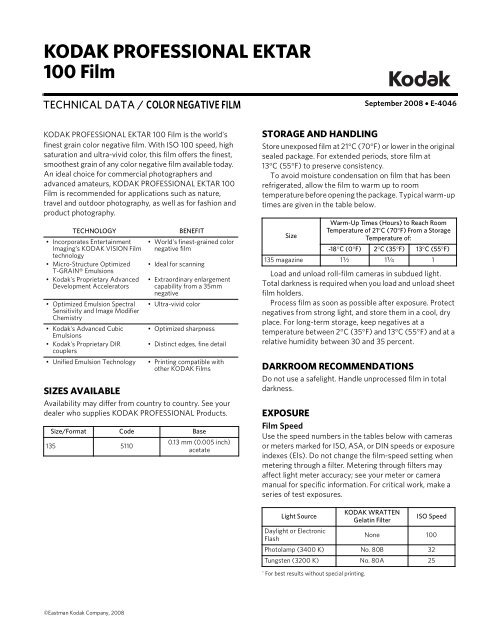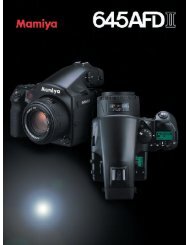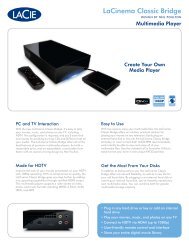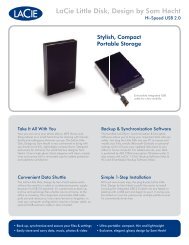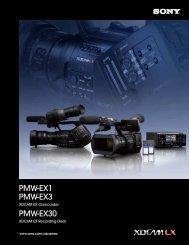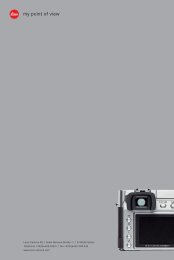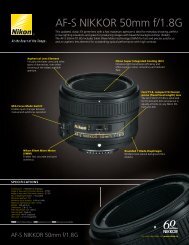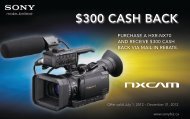Kodak Ektar 100 Datasheet PDF - Silverprint
Kodak Ektar 100 Datasheet PDF - Silverprint
Kodak Ektar 100 Datasheet PDF - Silverprint
- No tags were found...
Create successful ePaper yourself
Turn your PDF publications into a flip-book with our unique Google optimized e-Paper software.
KODAK PROFESSIONAL EKTAR<strong>100</strong> FilmTECHNICAL DATA / COLOR NEGATIVE FILMSeptember 2008 • E-4046KODAK PROFESSIONAL EKTAR <strong>100</strong> Film is the world'sfinest grain color negative film. With ISO <strong>100</strong> speed, highsaturation and ultra-vivid color, this film offers the finest,smoothest grain of any color negative film available today.An ideal choice for commercial photographers andadvanced amateurs, KODAK PROFESSIONAL EKTAR <strong>100</strong>Film is recommended for applications such as nature,travel and outdoor photography, as well as for fashion andproduct photography.TECHNOLOGYBENEFIT• Incorporates EntertainmentImaging’s KODAK VISION Filmtechnology• Micro-Structure Optimized • Ideal for scanningT-GRAIN® Emulsions• <strong>Kodak</strong>'s Proprietary AdvancedDevelopment Accelerators• Optimized Emulsion SpectralSensitivity and Image ModifierChemistry• <strong>Kodak</strong>'s Advanced CubicEmulsions• <strong>Kodak</strong>'s Proprietary DIRcouplers• Unified Emulsion Technology• World's finest-grained colornegative film• Extraordinary enlargementcapability from a 35mmnegative• Ultra-vivid color• Optimized sharpness• Distinct edges, fine detail• Printing compatible withother KODAK FilmsSIZES AVAILABLEAvailability may differ from country to country. See yourdealer who supplies KODAK PROFESSIONAL Products.Size/Format Code Base135 51<strong>100</strong>.13 mm (0.005 inch)acetateSTORAGE AND HANDLINGStore unexposed film at 21°C (70°F) or lower in the originalsealed package. For extended periods, store film at13°C (55°F) to preserve consistency.To avoid moisture condensation on film that has beenrefrigerated, allow the film to warm up to roomtemperature before opening the package. Typical warm-uptimes are given in the table below.Warm-Up Times (Hours) to Reach RoomSizeTemperature of 21°C (70°F) From a StorageTemperature of:-18°C (0°F) 2°C (35°F) 13°C (55°F)135 magazine 1 1 ⁄2 1 1 ⁄4 1Load and unload roll-film cameras in subdued light.Total darkness is required when you load and unload sheetfilm holders.Process film as soon as possible after exposure. Protectnegatives from strong light, and store them in a cool, dryplace. For long-term storage, keep negatives at atemperature between 2°C (35°F) and 13°C (55°F) and at arelative humidity between 30 and 35 percent.DARKROOM RECOMMENDATIONSDo not use a safelight. Handle unprocessed film in totaldarkness.EXPOSUREFilm SpeedUse the speed numbers in the tables below with camerasor meters marked for ISO, ASA, or DIN speeds or exposureindexes (EIs). Do not change the film-speed setting whenmetering through a filter. Metering through filters mayaffect light meter accuracy; see your meter or cameramanual for specific information. For critical work, make aseries of test exposures.Light SourceKODAK WRATTENGelatin FilterISO SpeedDaylight or ElectronicFlashNone <strong>100</strong>Photolamp (3400 K) No. 80B 32Tungsten (3200 K) No. 80A 25* For best results without special printing.©Eastman <strong>Kodak</strong> Company, 2008
DaylightUse the exposures in the table below for average frontlitsubjects from 2 hours after sunrise to 2 hours beforesunset.Lighting ConditionsBright or Hazy Sun on Light Sand orSnowShutter Speed (second)and Lens Opening1/125f/16Bright or Hazy Sun (Distinct Shadows) 1/125f/11 *Weak, Hazy Sun(Soft Shadows)Cloudy Bright(No Shadows)1/125f/81/125f/5.6Heavy Overcast or Open Shade ‡ 1/125f/4* Use f/5.6 for backlit close-up subjects.† Use f/8 for backlit close-up subjects.‡ Subject shaded from the sun but lighted by a large area of sky.Adjustments for Long and Short ExposuresNo filter correction or exposure compensation is requiredfor exposures from 1⁄10,000 second to 1 second. For criticalapplications with longer exposure times, make tests underyour conditions.Electronic FlashUse the appropriate guide number in the table below asstarting-point recommendations for your equipment.Select the unit output closest to the number given by yourflash manufacturer. Then find the guide number for feet ormetres. To determine the lens opening, divide the guidenumber by the flash-to-subject distance. If negatives areconsistently too dense (overexposed), use a higher guidenumber; if they are too thin (underexposed), use a lowernumber.Fluorescent and High-Intensity Discharge LampsUse the color-compensating filters and exposureadjustments in the tables below as starting points toexpose KODAK PROFESSIONAL EKTAR <strong>100</strong> Film underfluorescent or high-intensity discharge lamps. For criticalapplications, make a series of test exposures under youractual conditions.To avoid the brightness and color variations that occurduring a single alternating-current cycle, use exposuretimes of 1⁄60 second or longer with fluorescent lamps; withhigh-intensity discharge lamps, use exposure times of1⁄125 second or longer.Type of Fluorescent LampKODAK ColorCompensatingFilter(s)ExposureAdjustmentDaylight 20R + 5M +1 stopWhite 40B + 5C +1 2/3 stopWarm White 40B + 40C +2 stopsWarm White Deluxe 40B + 50C +2 stopsCool White 30B +1 stopCool White Deluxe 40C + 10M +1 stopHigh-Intensity DischargeLamp (CCT)KODAK ColorCompensatingFilter(s)ExposureAdjustmentHigh-Pressure SodiumVapor50B + 70C +2 2/3 stopsMetal Halide 5C + 10M +2/3 stopMercury Vapor withPhosphor30B + 5C+1 stopMercury Vapor withoutPhosphor80R+1 2/3 stopUnitOutput(BCPS) ** BCPS = beam candlepower secondsGuide NumberDistances in Feet/Metres350 40/12500 50/15700 60/18<strong>100</strong>0 70/211400 85/262000 <strong>100</strong>/302800 120/364000 140/425600 170/508000 200/602 KODAK PROFESSIONAL EKTAR <strong>100</strong> Film • E-4046
PROCESSINGProcess EKTAR <strong>100</strong> Film in KODAK FLEXICOLORChemicals for Process C-41 using the replenishment andwash rates in the tables below. Note that the developerreplenishment rates are starting-point recommendationsonly and may vary due to the amount of exposure to thefilm, scene content, and the presence/absence of sprocketholes.Replenishment and Wash RatesKODAKFLEXICOLORDeveloperReplenisherKODAKFLEXICOLORDeveloperReplenisher LORRKODAKFLEXICOLORBleach III,Fixer, andStabilizerWash Water *1012 mL/m 2 506 mL/m 2 861 mL/m 2 31 L/m 294 mL/ft 2 47 mL/ft 2 80 mL/ft 2 2.9 L/ft 2* Rates are for first wash and a two-stage countercurrent final wash. Doublethese rates for a single stage final wash.JUDGING NEGATIVE EXPOSURESYou can check the exposure level with a suitable electronicdensitometer equipped with a filter such as a KODAKWRATTEN Gelatin Filter No. 92 or the red filter forStatus M densitometry. Depending on the subject and thelight source used for exposure, a normally exposed andprocessed color negative measured through the red filtershould have the approximate densities listed below.Because of the extreme range in skin color, use these reddensity values for a normally lit forehead only as a guide.For best results, use a KODAK Gray Card (gray side).Area MeasuredKODAK Gray Card (gray side) receivingsame illumination as subjectLightest step (darkest in the negative) of aKODAK Paper Gray Scale receiving sameillumination as subjectHighest diffuse density on normally lightedforehead—light complexion—dark complexionDensity Reading0.77 to 0.871.13 to 1.231.08 to 1.180.93 to 1.03PRINTING NEGATIVESThis film is optimized for printing on KODAKPROFESSIONAL SUPRA ENDURA, SUPRA ENDURA VCDigital, ULTRA ENDURA, ULTRA ENDURA High Definition,and PRO IMAGE II Papers, and on KODAK PROFESSIONALENDURA Metallic Paper.Make color slides and transparencies by printing thenegatives on KODAK PROFESSIONAL ENDURATransparency Display Material or KODAKPROFESSIONAL ENDURA Clear Display Material.Make black-and-white prints on any of the materialsmentioned above using the recommendations in KODAKPublication CIS-274, Printing Black-and-White ImagesWithout KODAK Black-and-White Papers.To set up a color printer or negative analyzer, use thefollowing control negatives.KODAK PROFESSIONAL PORTRA PrinterControl NegativeCAT No.Set / Size 135 * 179 8511* This set includes one each: very under, under, normal, over, and very overnegatives.Digital FilesYou can scan your image to a file and print digitally to —KODAK PROFESSIONAL ENDURA Metallic PaperKODAK PROFESSIONAL SUPRA ENDURA PaperKODAK PROFESSIONAL SUPRA ENDURA VC DigitalPaperKODAK PROFESSIONAL ULTRA ENDURA PaperKODAK PROFESSIONAL ULTRA ENDURA HighDefinition PaperKODAK PROFESSIONAL PRO IMAGE II PaperKODAK PROFESSIONAL ENDURA TransparencyDisplay MaterialKODAK PROFESSIONAL ENDURA Clear DisplayMaterialRETOUCHINGRetouch only the emulsion side of 135 size film.For information on retouching equipment, supplies, andtechniques, see KODAK Publication No. E-71, RetouchingColor Negatives.KODAK PROFESSIONAL EKTAR <strong>100</strong> Film • E-4046 3
SCANNING NEGATIVESYou can easily scan EKTAR <strong>100</strong> Film negatives with avariety of linear-array-CCD, area-array-CCD, and PMT filmscanners. You can scan negatives on desktop scanners aswell as high-end drum scanners.Because no standards exist to define the colored filtersets that film scanners use to capture the red, green, andblue information of the film image, each manufacturer’sscanner has its own characteristic output. The outputdepends on the scanner’s sensitivity to the dyes in the film.This sensitivity is determined by the spectral distributionof the colored filter sets and/or the spectral sensitivity ofthe charge-coupled-device (CCD). In addition to thesespectral specifications, scanner output depends on thelook-up tables or matrices that the scanner uses to outputinformation for CRT monitors, transmission, etc. Thesetables or matrices are part of either “plug-in” programsused with specific software packages designed for imagemanipulation, updateable ROMs included with theequipment, or fixed algorithms for calibrating andbalancing, similar to those used in photographic colorprinting equipment.The generic “color negative film” channel designationavailable with scanner software is only a starting point.You can adjust the final color balance and thescene-dependent contrast and brightness of an image byusing the scanner’s controls during pre-scan, or by usingan image-manipulation software program or workstationafter acquisition. Some scanners allow you to use “plug-in”programs to customize scanner setups.For more information, visit the following Web sites.To accessFilm Terms for KODAKPHOTO CD ImagingWorkstationsDrivers for KODAK FilmScannersGo towww.kodak.com/go/pcdFilmTermswww.kodak.com/go/scannerDriversIMAGE STRUCTUREPrint Grain IndexThe Print Grain Index number refers to a method ofdefining graininess in a print made with diffuse-printingillumination. It replaces rms granularity and has a differentscale which cannot be compared to rms granularity.• The method uses a uniform perceptual scale, with achange of four units equaling a just noticeable differencein graininess to 90 percent of observers.• A Print Grain Index rating of 25 on the scale representsthe approximate visual threshold for graininess. Ahigher number indicates an increase in the amount ofgraininess observed.• The standardized inspection (print-to-viewer)distance for all print sizes is 14 inches, the typicalviewing distance for a 4 x 6-inch print.• In practice, larger prints will likely be viewed fromdistances greater than 14 inches, which reducesapparent graininess.• Print Grain Index numbers may not representgraininess observed from more specular printingilluminants, such as condenser enlargers.Print Size in inches 4x6 8x10 16x20Magnification 4.4X 8.8X 17.8XPrint Grain Index less than 25 * 38 66* 25 is the visual threshold for perception of grain.For more information, see KODAK Publication No.E-58, Print Grain Index—An Assessment of Print Graininessfrom Color Negative Films.4 KODAK PROFESSIONAL EKTAR <strong>100</strong> Film • E-4046
CURVESCharacteristic CurvesSpectral-Dye-Density CurvesDENSITY4.03.02.01.0Exposure: DaylightDensitometry: Status MLog H Ref: -0.84BGRDIFFUSE SPECTRAL DENSITY2.52.01.51.00.5Typical densities for a midscale neutral subjectand D-min.Minimum DensityMidscale Neutral0.0-3.0E4046A-2.0 -1.0 0.0 1.0 2.0LOG EXPOSURE (lux-seconds)E4046C0.0400450 500 550 600 650WAVELENGTH (nm)700Spectral-Sensitivity CurvesModulation Transfer FunctionLOG SENSITIVITY*3.02.01.0Exposure: DaylightEffective Exposure: 1/25 SecondDensitometry: Status MDensity: 0.2>D-minYellow-FormingLayerMagenta-FormingLayerCyan-FormingLayerRESPONSE (%)200<strong>100</strong>705030201075BGRE4046B0.0250300350400 450 500 550 600WAVELENGTH (nm)650*Sensitivity = reciprocal of exposure (erg/cm ) requiredto produce specified density2700 750321E4046DExposure: DaylightProcess: C-411 2 3 4 5 10 20 50 <strong>100</strong> 200 600SPATIAL FREQUENCY (cycles/mm)NOTICE: The sensitometric curves and data in this publication represent product testedunder the conditions of exposure and processing specified. They are representative ofproduction coatings, and therefore do not apply directly to a particular box or roll ofphotographic material. They do not represent standards or specifications that must bemet by Eastman <strong>Kodak</strong> Company. The company reserves the right to change andimprove product characteristics at any time.5 KODAK PROFESSIONAL EKTAR <strong>100</strong> Film • E-4046
KODAK PROFESSIONAL EKTAR <strong>100</strong> FilmMORE INFORMATION<strong>Kodak</strong> has many publications to assist you withinformation on KODAK Products, Equipment, andMaterials.The following publications are available from <strong>Kodak</strong>Customer Service, or you can contact <strong>Kodak</strong> in yourcountry for more information.E-30 Storage and Care of KODAK PhotographicMaterials—Before and After ProcessingE-58 Print Grain IndexE-71 Retouching Color NegativesE-4021 KODAK PROFESSIONAL PORTRA and SUPRAENDURA PapersE-4020 KODAK PROFESSIONAL ULTRA ENDURA PaperE-4038 KODAK PROFESSIONAL ENDURA Transparencyand Clear Display MaterialsE-4028 KODAK PROFESSIONAL ENDURA MetallicPaperE-4042 KODAK PROFESSIONAL SUPRA ENDURA VCDigital PaperE-4044 KODAK PROFESSIONAL ULTRA ENDURA HighDefinition PaperE-4002 KODAK PROFESSIONAL PRO IMAGE II PaperE-4040 KODAK PROFESSIONAL PORTRA FilmsE-4035 KODAK PROFESSIONAL ULTRA COLOR <strong>100</strong>UCand 400UC FilmsJ-38 Using KODAK FLEXICOLOR Chemicals inSink-Line, Bath, and Rotary-Tube ProcessorsZ-131 Using KODAK FLEXICOLOR ChemicalsFor the latest version of technical support publications for KODAKPROFESSIONAL Products, visit <strong>Kodak</strong> on-line at:http://www.kodak.com/go/professionalIf you have questions about KODAK PROFESSIONAL Products,call <strong>Kodak</strong>.In the U.S.A.:1-800-242-2424, Ext. 19, Monday–Friday9 a.m.–7 p.m. (Eastern time)In Canada:1-800-465-6325, Monday–Friday8 a.m.–5 p.m. (Eastern time)Note: The <strong>Kodak</strong> materials described in this publication foruse with KODAK PROFESSIONAL EKTAR <strong>100</strong> Film areavailable from dealers who supply KODAKPROFESSIONAL Products. You can use other materials,but you may not obtain similar results.<strong>Kodak</strong>, <strong>Kodak</strong> Professional, <strong>Ektar</strong>, Endura, Flexicolor, Pro Image, Portra, Supra, T-Grain,Ultra, Vision, and Wratten are trademarks.New 9-08Printed in U.S.A.KODAK PROFESSIONAL EKTAR <strong>100</strong>FilmKODAK Publication No. E-4046Film, Photofinishing & Entertainment GroupEASTMAN KODAK COMPANY • ROCHESTER, NY 14650


